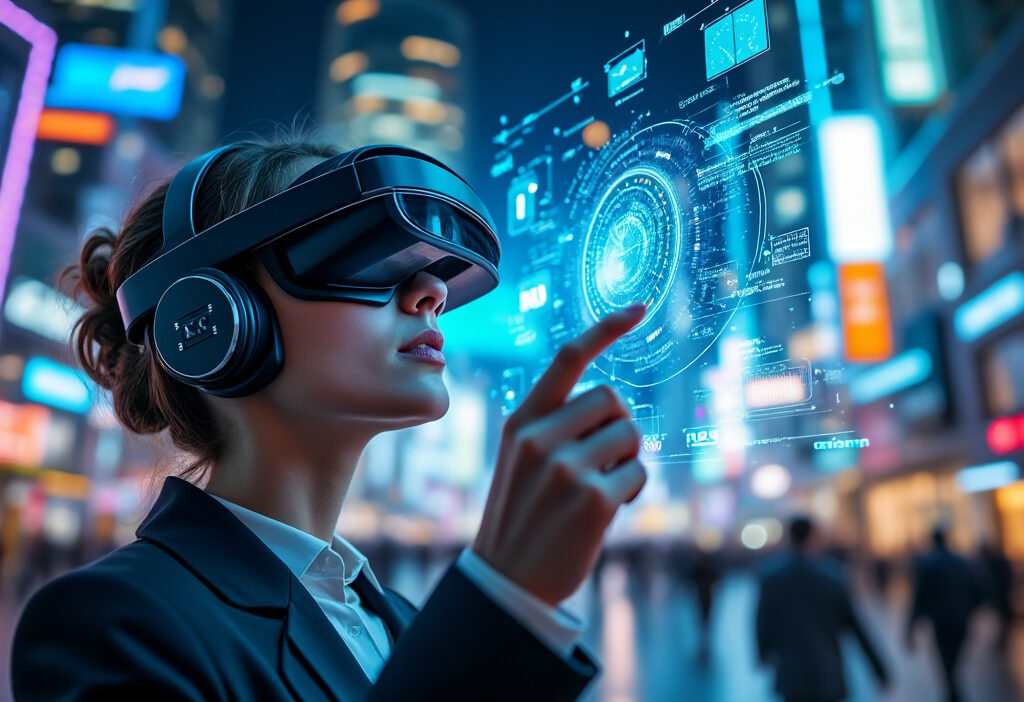Exploring the World of Augmented Reality
Augmented Reality (AR) is revolutionizing the way we interact with the world around us. By overlaying digital information onto the physical environment, AR enhances our perception and offers immersive experiences across various sectors. From gaming to education, AR’s applications are vast and growing. This article delves into the intricacies of AR, exploring its technology, applications, and future potential.
The Foundation of Augmented Reality
Augmented reality (AR) is a technology that overlays digital content onto the real world, enhancing our perception of reality rather than replacing it entirely. Unlike virtual reality (VR), which immerses users in a fully synthetic environment, AR blends virtual elements with the physical world in real time. This distinction is crucial—while VR requires headsets that block out the real world, AR can be experienced through smartphones, smart glasses, or even projection-based systems, making it more accessible and versatile.
At its core, AR relies on three key components: sensors, processing power, and display technology. Sensors, such as cameras, GPS, and accelerometers, gather real-world data to understand the user’s environment. Processing units, often powered by machine learning algorithms, interpret this data and determine where and how to place digital objects. Finally, display technology renders these virtual elements seamlessly into the user’s field of view. Modern AR systems use techniques like simultaneous localization and mapping (SLAM) to track the user’s position and anchor digital objects in physical space with high precision.
Another fundamental aspect of AR is its ability to recognize and interact with real-world objects. Through computer vision, AR applications can identify surfaces, objects, or even faces, enabling dynamic interactions. For example, an AR app might project furniture into a room by detecting walls and floors, or overlay navigation arrows on a street view using GPS and camera input.
The flexibility of AR makes it applicable across industries—from gaming and retail to healthcare and education. Unlike VR, which demands isolation, AR enhances reality without disconnecting users from their surroundings, offering a more natural and integrated experience. As we explore the evolution of AR in the next chapter, it’s important to recognize how these foundational principles have shaped its development and widespread adoption.
The Evolution of AR Technology
Augmented reality (AR) has undergone a remarkable evolution since its conceptual beginnings, transforming from rudimentary experiments into a sophisticated technology that reshapes how we interact with the world. The journey began in the 1960s with Ivan Sutherland’s “Sword of Damocles”, a head-mounted display that laid the groundwork for AR, but it wasn’t until the 1990s that AR truly started taking shape. Researchers like Tom Caudell at Boeing coined the term “augmented reality” while developing a system to assist aircraft assembly workers with digital overlays.
The late 1990s and early 2000s saw AR’s first practical applications in industrial and military settings. The ARToolKit, developed in 1999, was a pivotal open-source framework that enabled marker-based AR, allowing digital content to interact with physical markers. Meanwhile, NASA integrated AR into astronaut training, demonstrating its potential beyond niche industrial uses.
The smartphone revolution in the 2010s democratized AR, with apps like Layar and Pokémon GO bringing AR to mainstream audiences. Apple’s ARKit (2017) and Google’s ARCore (2018) further accelerated adoption by embedding AR capabilities into mobile devices, eliminating the need for specialized hardware. These frameworks leveraged advanced computer vision, depth sensing, and motion tracking to create seamless digital overlays in real-world environments.
Today, AR has expanded into wearable devices like Microsoft HoloLens and Magic Leap, which use spatial computing to blend digital and physical worlds more naturally. Modern AR systems incorporate machine learning, LiDAR, and SLAM (Simultaneous Localization and Mapping) to enable precise, context-aware augmentations. As AR continues evolving, its integration with AI and 5G promises even more immersive and responsive experiences, setting the stage for the next leap in human-computer interaction.
How AR Works
Augmented Reality (AR) operates by seamlessly blending digital content with the physical world, creating an interactive experience that feels natural and immersive. At its core, AR relies on a combination of hardware and software working in harmony to recognize, process, and overlay digital elements onto real-world environments.
The foundation of AR lies in computer vision, a field of artificial intelligence that enables devices to interpret visual data. Using cameras and sensors, AR systems capture the surrounding environment and analyze it in real time. Algorithms identify surfaces, edges, and spatial relationships to anchor digital objects accurately. For example, when placing a virtual chair in a room, the system must understand the floor’s dimensions and lighting to make the object appear realistic.
Object recognition further enhances AR by identifying specific items or markers in the physical world. This can range from QR codes to complex 3D models, allowing AR applications to trigger context-aware digital overlays. Advanced machine learning techniques enable devices to recognize objects without predefined markers, making interactions more intuitive.
The integration of digital and physical worlds is achieved through spatial mapping and rendering engines. Spatial mapping creates a 3D model of the environment, while rendering engines generate photorealistic digital content that aligns with real-world physics. Technologies like SLAM (Simultaneous Localization and Mapping) track the user’s position relative to the environment, ensuring stable and responsive AR experiences.
Modern AR frameworks, such as ARKit and ARCore, leverage these principles to empower developers. By combining sensor data, computer vision, and powerful processors, AR transforms how we perceive reality—setting the stage for its revolutionary applications in entertainment, gaming, and beyond.
AR in Entertainment and Gaming
Augmented reality has revolutionized the entertainment and gaming industries by blending digital elements seamlessly into the real world, creating immersive experiences that were once the stuff of science fiction. Unlike traditional gaming, which confines players to screens, AR games encourage physical movement and interaction with the environment, making gameplay more dynamic and engaging.
One of the most iconic examples is Pokémon GO, which took the world by storm in 2016. By overlaying digital creatures onto real-world locations, the game turned parks, streets, and landmarks into interactive playgrounds. Its success demonstrated AR’s potential to merge gaming with physical activity and social interaction, fostering communities of players who explore their surroundings together. Similarly, Harry Potter: Wizards Unite expanded on this concept, allowing fans to cast spells and encounter magical creatures in their neighborhoods.
Beyond gaming, AR is transforming live entertainment. Concerts and theater productions now incorporate AR to enhance performances with holographic effects, interactive backdrops, and audience participation. Apps like Snapchat and Instagram leverage AR filters to let users modify their appearances or surroundings in real time, turning everyday moments into shareable, creative experiences.
The technology also enables new forms of storytelling. Interactive AR books and apps bring characters to life, allowing children—and adults—to engage with narratives in three-dimensional space. Meanwhile, theme parks and museums use AR to add layers of information and interactivity to exhibits, deepening visitor engagement.
As AR hardware improves—with advancements in wearables like AR glasses—the line between digital and physical entertainment will blur even further, unlocking possibilities we’ve only begun to imagine.
Educational Applications of AR
Augmented reality is revolutionizing education by transforming traditional learning environments into dynamic, interactive spaces. Unlike passive textbook learning or one-way lectures, AR brings abstract concepts to life, allowing students to visualize and manipulate complex ideas in real time. For instance, anatomy students can explore 3D holograms of the human body, peeling back layers to examine muscles, bones, and organs without needing physical dissection. Similarly, chemistry students can simulate molecular interactions, watching bonds form and break in an immersive, risk-free environment.
One of AR’s greatest strengths in education is its ability to cater to diverse learning styles. Visual learners benefit from interactive models, while kinesthetic learners engage through hands-on AR activities. Language students, for example, can point their devices at objects to see translations overlay in real time, reinforcing vocabulary through contextual learning. History classes are also being reimagined—students can witness historical events unfold in their classrooms or even explore ancient civilizations through AR-powered field trips.
Beyond K-12 and higher education, AR is making waves in professional training. Medical students practice virtual surgeries, engineers troubleshoot 3D mechanical models, and technicians receive step-by-step AR-guided instructions for complex repairs. This hands-on approach reduces training costs while improving retention and skill mastery.
The adaptability of AR also bridges gaps in remote learning. Students in underserved areas can access high-quality educational resources, leveling the playing field. As AR tools become more affordable and widespread, their potential to democratize education grows exponentially. With seamless integration into curricula, AR isn’t just supplementing education—it’s redefining how knowledge is absorbed and applied, setting the stage for even more transformative uses in fields like healthcare.
AR in Healthcare
Augmented reality is revolutionizing healthcare by bridging the gap between digital precision and real-world medical practice. Unlike its educational counterpart, which focuses on engagement and interactivity, AR in healthcare prioritizes accuracy, efficiency, and patient outcomes. One of the most groundbreaking applications is in surgical assistance, where AR overlays critical data—such as 3D anatomical models or real-time vitals—directly onto a surgeon’s field of view. This minimizes guesswork, reduces errors, and shortens procedure times. For instance, platforms like Microsoft HoloLens enable surgeons to visualize CT scans in 3D during operations, enhancing precision in complex cases like tumor removals or spinal surgeries.
Beyond the operating room, AR is transforming patient education. Traditional methods often rely on static diagrams or verbal explanations, which can be hard to grasp. AR, however, allows patients to interact with dynamic, personalized models of their own conditions. A cardiologist, for example, can project a beating heart with blocked arteries, helping patients understand their diagnosis and treatment options more intuitively. This fosters better compliance and reduces anxiety.
Therapy is another area where AR shines. For physical rehabilitation, AR-guided exercises provide real-time feedback, ensuring correct form and progression. In mental health, exposure therapy for phobias or PTSD is made safer and more controlled through AR simulations, allowing patients to confront triggers in a manageable environment.
As we transition to discussing AR in retail, it’s clear that healthcare’s use of the technology is uniquely life-altering. While retail focuses on enhancing consumer experiences, healthcare leverages AR to save lives, improve outcomes, and empower both practitioners and patients with unprecedented clarity. The potential is vast, and as AR hardware becomes more accessible, its adoption in medicine will only accelerate.
Augmented Reality in Retail
Augmented reality is revolutionizing the retail industry by bridging the gap between physical and digital shopping experiences. Retailers are leveraging AR to create immersive, interactive, and personalized engagements that go beyond traditional browsing. One of the most impactful applications is virtual try-ons, allowing customers to visualize products like clothing, makeup, or eyewear in real-time using their smartphone cameras. Brands such as Sephora and Warby Parker have integrated AR mirrors and apps that enable shoppers to “try before they buy,” reducing returns and boosting confidence in purchases.
Another key innovation is in-store navigation, where AR overlays digital directions or product information onto a live store environment. Walmart and IKEA have experimented with AR wayfinding, helping customers locate items quickly by following virtual markers on their screens. This not only enhances convenience but also encourages exploration of additional products.
Furniture retailers like IKEA and Wayfair take AR a step further with spatial visualization, letting users place virtual furniture in their homes to assess fit and style. This eliminates guesswork and increases conversion rates. Meanwhile, luxury brands such as Gucci use AR for exclusive virtual drops, where limited-edition digital items can be “worn” in AR before purchasing the physical counterpart.
AR also powers interactive packaging, where scanning a product’s label unlocks tutorials, promotions, or brand stories. Coca-Cola and L’Oréal have used this to deepen customer engagement. By blending digital enhancements with real-world shopping, AR is transforming retail into a dynamic, data-driven experience—setting the stage for even more immersive communication tools, as we’ll explore in the next chapter.
The Role of AR in Communication
Augmented Reality is revolutionizing communication by blending digital elements with the physical world, creating immersive and interactive experiences that go beyond traditional methods. One of the most visible applications is in social media filters, where platforms like Snapchat, Instagram, and TikTok use AR to overlay playful animations, beauty enhancements, or even branded content onto users’ faces in real time. These filters aren’t just for entertainment—they’ve become a new language of self-expression, enabling users to convey emotions, affiliations, or cultural trends in ways that text or static images cannot.
In professional settings, AR is transforming virtual meetings by making remote collaboration more engaging. Tools like Microsoft Mesh or Spatial allow participants to share 3D holograms, annotate real-world objects, or even appear as lifelike avatars in a shared virtual space. This goes beyond video calls, offering a sense of presence and spatial awareness that mimics in-person interactions. For industries like architecture or engineering, AR enables teams to manipulate 3D models in real time, making complex discussions more intuitive.
AR also enhances accessibility in communication. Live translation apps like Google Translate use AR to overlay translated text onto street signs or menus, breaking language barriers instantly. Similarly, AR-powered sign language avatars can assist in real-time interpretation, making conversations more inclusive.
However, as AR communication tools become more sophisticated, they raise questions about privacy and digital identity—topics that will be explored in the next chapter. While AR enriches how we connect, its reliance on cameras and data collection necessitates careful consideration of ethical implications. The line between reality and augmentation is blurring, and with it, our very definition of interaction is evolving.
Challenges and Limitations of AR
While augmented reality (AR) has made significant strides in reshaping communication and interaction, the technology still faces several challenges that hinder its widespread adoption. Technical limitations remain one of the biggest obstacles. AR requires high computational power, precise spatial mapping, and low-latency processing to deliver seamless experiences. Current hardware, like smart glasses, often struggles with battery life, overheating, and limited field of view, making prolonged use impractical. Additionally, achieving accurate real-world object recognition in dynamic environments remains a hurdle, as lighting conditions and occlusions can disrupt AR overlays.
Privacy concerns are another critical issue. AR applications often rely on cameras and sensors to collect vast amounts of environmental and user data, raising questions about data security and consent. Unauthorized surveillance, facial recognition misuse, and location tracking could lead to ethical dilemmas and regulatory scrutiny. Without robust privacy frameworks, user trust in AR may erode, stifling adoption.
User adoption is also a challenge. Despite AR’s potential, many consumers still perceive it as a novelty rather than a necessity. The lack of compelling, everyday applications beyond gaming and social media filters limits its appeal. Moreover, the learning curve for new users and the social awkwardness of wearing AR devices in public create barriers to mainstream acceptance.
Finally, content creation for AR remains complex, requiring specialized skills in 3D modeling and spatial computing. Without streamlined tools for developers and creators, the pace of innovation may slow. Addressing these challenges—through advancements in hardware, stronger privacy protections, and more intuitive interfaces—will be crucial for AR to move beyond niche applications and truly integrate into daily life, setting the stage for its future evolution.
The Future of Augmented Reality
The future of augmented reality (AR) is poised to redefine how we interact with the digital and physical worlds, driven by rapid advancements in hardware, software, and user experience design. As AR overcomes its current limitations—such as hardware bulkiness and processing constraints—it will evolve into a seamless, ubiquitous technology. One of the most anticipated developments is the shift from headsets to lightweight, stylish smart glasses with advanced optics, capable of delivering high-resolution, wide-field-of-view displays. These devices will integrate AI-driven contextual awareness, enabling real-time object recognition, spatial mapping, and personalized content overlays.
Industries will see transformative applications:
- Healthcare: Surgeons could use AR for real-time, hands-free visualization of patient data during procedures, while medical training could incorporate immersive 3D anatomical models.
- Retail: Virtual try-ons and interactive product displays will become standard, blurring the line between online and in-store shopping.
- Education: AR will enable interactive, location-based learning, turning classrooms and museums into dynamic, immersive environments.
- Manufacturing: Workers will access real-time assembly instructions, remote expert assistance, and predictive maintenance alerts overlaid on machinery.
Beyond these applications, AR will merge with other emerging technologies. The integration of 5G networks will enable low-latency, cloud-based AR experiences, while advancements in haptic feedback and spatial audio will deepen immersion. Social AR will also flourish, allowing users to share persistent virtual objects in physical spaces, creating collaborative mixed-reality environments.
Ethical and societal implications will arise as AR becomes more pervasive. Issues like digital addiction, privacy in public spaces, and the potential for misinformation through manipulated overlays will require careful regulation. However, if these challenges are addressed, AR could become as integral to daily life as smartphones are today, fundamentally altering how we perceive and interact with reality.

Conclusions
Augmented Reality is more than just a technological novelty; it’s a transformative tool that’s reshaping industries and enhancing our daily lives. From its foundational technology to its wide-ranging applications, AR offers a glimpse into a future where digital and physical worlds seamlessly merge. As we continue to explore and innovate, the possibilities for AR are boundless.



